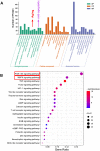Elucidating the anti-aging mechanism of Si Jun Zi Tang by integrating network pharmacology and experimental validation in vivo
- PMID: 35537009
- PMCID: PMC9134961
- DOI: 10.18632/aging.204055
Elucidating the anti-aging mechanism of Si Jun Zi Tang by integrating network pharmacology and experimental validation in vivo
Abstract
Si Jun Zi Tang (SJZT) is a classic Traditional Chinese Medicine (TCM) prescription used to treat aging-related diseases. However, the potential molecular mechanisms of the anti-aging effects of the bioactive compounds and their targets remain elusive. In this study, we combined network pharmacology and molecular docking with in vivo experiments to elucidate the anti-aging molecular mechanism of SJZT. A series of network pharmacology strategies were used to predict potential targets and therapeutic mechanisms of SJZT, including compound screening, pathway enrichment analysis and molecular docking studies. Based on the network pharmacology predictions and observation of outward signs of aging, the expression levels of selected genes and proteins and possible key targets were subsequently validated and analysed using qRT-PCR and immunoblotting. Using a data mining approach, 235 effective targets of SJZT and aging were obtained. AKT1, STAT3, JUN, MAPK3, TP53, MAPK1, TNF, RELA, MAPK14 and IL6 were identified as core genes in the Protein-Protein Interaction Networks (PPI) analysis. The results of the effective target Gene Ontology (Go) functional enrichment analysis suggested that SJZT may be involved aging and antiapoptotic biological processes. The Kyoto Encyclopedia of Genes and Genomes (KEGG) enrichment analysis indicated that the anti-aging mechanism of SJZT may be associated with the PI3K-AKT and P38 MAPK signalling pathways. Molecular docking analysis suggested that kaempferol and quercetin could fit in the binding pockets of the core targets. In addition, SJZT alleviated the aging symptoms of mice such as osteoporosis and hair loss. In conclusion, the anti-aging effect of SJZT was associated with the inhibition of the PI3K-AKT and P38 MAPK signalling pathways, and these findings were consistent with the network pharmacology prediction.
Keywords: SJZT; aging; experimental validation; network pharmacology.
Conflict of interest statement
Figures






Similar articles
-
Study on the anti-skin aging effect and mechanism of Sijunzi Tang based on network pharmacology and experimental validation.J Ethnopharmacol. 2024 Oct 28;333:118421. doi: 10.1016/j.jep.2024.118421. Epub 2024 Jun 14. J Ethnopharmacol. 2024. PMID: 38880400
-
A network pharmacology approach and experimental validation to investigate the anticancer mechanism and potential active targets of ethanol extract of Wei-Tong-Xin against colorectal cancer through induction of apoptosis via PI3K/AKT signaling pathway.J Ethnopharmacol. 2023 Mar 1;303:115933. doi: 10.1016/j.jep.2022.115933. Epub 2022 Nov 18. J Ethnopharmacol. 2023. PMID: 36403742
-
Network Pharmacology Prediction and Molecular Docking-Based Strategy to Discover the Potential Pharmacological Mechanism of Huai Hua San Against Ulcerative Colitis.Drug Des Devel Ther. 2021 Jul 28;15:3255-3276. doi: 10.2147/DDDT.S319786. eCollection 2021. Drug Des Devel Ther. 2021. PMID: 34349502 Free PMC article.
-
Network pharmacology prediction and molecular docking-based strategy to explore the potential mechanism of Huanglian Jiedu Decoction against sepsis.Comput Biol Med. 2022 May;144:105389. doi: 10.1016/j.compbiomed.2022.105389. Epub 2022 Mar 9. Comput Biol Med. 2022. PMID: 35303581 Review.
-
Investigating the therapeutic mechanism of Xiaotan Sanjie Formula for gastric cancer via network pharmacology and molecular docking: A review.Medicine (Baltimore). 2023 Nov 17;102(46):e35986. doi: 10.1097/MD.0000000000035986. Medicine (Baltimore). 2023. PMID: 37986339 Free PMC article. Review.
Cited by
-
Targeting cellular senescence in senile osteoporosis: therapeutic potential of traditional Chinese medicine.Front Med (Lausanne). 2023 Nov 24;10:1288993. doi: 10.3389/fmed.2023.1288993. eCollection 2023. Front Med (Lausanne). 2023. PMID: 38076228 Free PMC article. Review.
-
Acupuncture Combined with Bushen-Jianpi Decoction Ameliorates the Ovarian Function of Diminished Ovarian Reserve Rats by Regulating Phosphoinositide 3-Kinase/AKT Signaling.Comb Chem High Throughput Screen. 2024;27(16):2402-2418. doi: 10.2174/0113862073264971231113061204. Comb Chem High Throughput Screen. 2024. PMID: 38178681
-
Exploring the potential mechanism of Taohong Siwu decoction in the treatment of avascular necrosis of the femoral head based on network pharmacology and molecular docking.Medicine (Baltimore). 2023 Dec 15;102(50):e35312. doi: 10.1097/MD.0000000000035312. Medicine (Baltimore). 2023. PMID: 38115279 Free PMC article.
-
Network pharmacology-based approach to investigate the molecular targets and molecular mechanisms of Rosmarinus officinalis L. for treating aging-related disorders.Biogerontology. 2024 Oct;25(5):793-808. doi: 10.1007/s10522-024-10122-w. Epub 2024 Jul 17. Biogerontology. 2024. PMID: 39017748 Review.
-
Elucidating the anti-aging bioactive compounds and mechanisms of Jingfang Granules formula based on network pharmacology and Caenorhabditis elegans.Biogerontology. 2025 Jun 24;26(4):127. doi: 10.1007/s10522-025-10276-1. Biogerontology. 2025. PMID: 40553174
References
-
- Dey AB. World report on aging and health. Indian J Med Res. 2017; 145:150–1. 10.4103/0971-5916.207249 - DOI
-
- Xiao G, Xuan Z, Xiaozhen G, Xiaohong Z, Ying S. Modified Sijunzi Decoction delays spleen tissue aging in mice through mTOR signaling. Academic Journal of Second Military Medical University. 2020; 41:1410–3. 10.16781/j.0258-879x.2020.12.1410. - DOI
Publication types
MeSH terms
Substances
LinkOut - more resources
Full Text Sources
Research Materials
Miscellaneous

